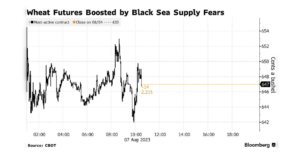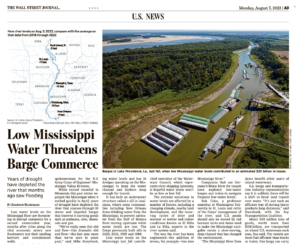Bloomberg's Clarice Couto reported this past Friday that "a surprising tax change in agriculture powerhouse Brazil has the potential to make soy grown in the world’s largest bean exporter less…
Wheat Climbs on Black Sea Tensions, While Heat Takes Toll on U.S. Cattle, and Low Mississippi River Water a Concern
Financial Times writer Gloria Li reported today that, “Wheat prices climbed on Monday after Ukraine’s drone strikes against a Russian naval vessel and oil tanker over the weekend raised concerns over the potential impact on supply from the world’s largest exporter.
“Chicago wheat futures rose as much as 3.4 per cent to a high of $6.545 per bushel, extending gains from the previous trading. Corn futures dropped 0.21 per cent, surrendering part of Friday’s rally.
“Ukraine damaged a Russian warship in an overnight sea drone attack on Russia’s crude-exploiting Black Sea port of Novorossiysk on Friday. On Saturday, Kyiv used another drone to attack a Russian oil tanker in the Kerch Strait.”
Bloomberg writers Keira Wright and Megan Durisin reported today that, “Wheat extended gains after Ukraine used sea drones to cripple a Russian naval vessel and an oil tanker over the weekend, posing a risk for a key export route for Russian commodities through the Black Sea.

“Top wheat shipper Russia moves most of its grain through the waterway. It is in the midst of a second bumper harvest, making this a crucial time for getting crops to markets and ensuring enough supply to constrain global food costs.”
A separate Bloomberg News article today reported that, “The footprint of President Vladimir Putin’s war on Ukraine is growing fast after a weekend in which sea drones crippled a Russian naval vessel and an oil tanker.
For the first time, the attacks put at risk Russia’s commodity exports via the Black Sea, a route that accounts for most of the grain and 15% to 20% of the oil that Russia sells daily on global markets. Significantly higher insurance and shipping costs are likely to follow for Moscow, but there are risks to European and global markets, too.
Also today, Reuters writer Enrico Dela Cruz reported that, “Chicago wheat rose more than 2% on Monday, extending gains from the previous session amid global supply concerns spurred by an escalation of tensions in the Black Sea after last week’s Ukrainian drone attack near a Russian export hub.
“Expectations of demand from India also underpinned wheat prices as the country considers cutting or abolishing tariffs on the grain.”
Meanwhile, Reuters writer Pavel Polityuk reported today that, “Ukraine’s grain exports have risen to 2.56 million metric tons so far in the 2023/24 July-June season from 2 million tons at the same time of the season last year, Agriculture Ministry data showed on Monday.
“Exports have been affected since Russia quit a United Nations-backed grain deal last month but the ministry’s data did not give a breakdown on exports since the deal collapsed.”
Elsewhere, Bloomberg writer Hallie Gu reported today that, “Heavy rains lashing China’s northeast are ravaging crops in some areas of the country’s grain basket, threatening to increase imports at a time of rising food insecurity across the globe.
“Recent flooding has destroyed rice planted in parts of Jilin and Heilongjiang provinces, local media reported. The rains are expected to continue across most of the region this week as typhoon season continues to wreak havoc, raising the risk that more agricultural land will be inundated, according to the National Meteorological Center.
“The northeastern region, which also includes the province of Liaoning and Inner Mongolia, produces almost 30% of China’s grains, accounting for 45% of the national corn harvest, 60% of soybeans and 20% of rice.”
In other news, Reuters writer Tom Polansek reported today that, “Hundreds of cattle died in Iowa from extreme heat and humidity in late July, the state and livestock producers said, as the world recorded its hottest month ever.
“The deaths show the toll of severe weather on farm animals and food production. The losses further trim the U.S. cattle herd, which is already the smallest in decades after drought drove ranchers to slaughter more cows due to a lack of pasture to feed them.”

And Wall Street Journal writer Shannon Najmabadi reported in today’s paper that, “Low water levels on the Mississippi River are threatening to disrupt commerce for a second consecutive year, months after cities along the vital economic artery saw floodwaters test their sandbag barriers and containment walls.
“Water levels in St. Louis and Memphis are 10 to 20 feet lower at this point in the year than in 2020 and 2019 due to lack of rain. Parched soils have absorbed moisture instead of letting it run off into the river, though recent downpours have helped, said Lisa Parker, spokeswoman for the U.S. Army Corps of Engineers’ Mississippi Valley Division.”
“The Army Corps of Engineers has begun monitoring water levels and has 16 dredges operating on the Mississippi River to keep the water channel and harbors deep enough for transit,” the Journal article said.







